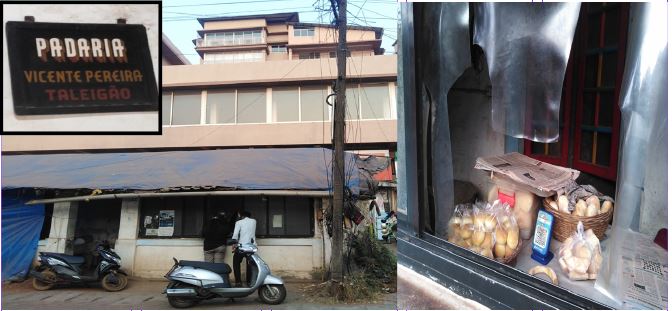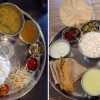Goa is abuzz with excitement as vintage bike and car owners, users, collectors and fans are decking […]

DISCOVERING THE `PODERACHO BOL’…
April 13- April 19 2024, Eating is Fun / Eating is Yuck! - A variety food column, Life & Living April 12, 2024Oldest local bakery down Caranzalem street…. Padaria Vicente Pereira, over a hundred years old? Very popular with local bread lovers and offers a large selection of Goans breads pao, poie, undo, katre, kakon and now poderache bol only on Sunday evenings, which very few bakeries make now!
By Tara Narayan
LIFE can become tiresome when two people in a family have different drinking and eating eccentricities, if you want to call it that! For example, as one learned more and more about what one should put in one’s mouth morning, noon or night…one may be predominantly acidic in taste, while the other may be utterly alkaline! Say I may like to begin the day with a tablespoon of aonla juice or a glass of fresh ginger lemon watered down juice; the better half or three-quarters may want tea and more sweetened tea or coffee. What’s an acidic and what’s an alkaline way to start the day? You tell me! Generally, cooked is acidic, depending on various grades of cooking; while consumption of fresh cut salads is predominantly alkaline and offers vital life-strengthening enzymes which we never get in cooked dishes (if you discount the fresh garnishing of herbal greens like chopped green coriander or mint or spring onions or whatever else you like).
Tea and coffee is generally speaking considered an acidic habit although a cup or two may not make such a big difference to the health of your kidneys and liver, I dare say. Still, then again, one may like wheat roti and rice-dal kichdi, while the rest of the family may want a millet kichdi or roti! One may like a cut salad, the other will say, “Please give me soup, bread and cheese or Mangalore bun, and some jalebi for dessert today seeing that it is Ugadi today!” All things sugar and carbohydrates add to acidity, towards a predominantly acidic homeostatis which the body is constantly fighting to keep at bay, for it is acidic chemistries which invite inflammation and degeneration of body beautiful from the inside out. A slow or fast burn out!
USUALLY in the traditional Hindu homes of old I’ve seen what happens in a family, the men of the house get their meals first be they good, bad or ugly for their digestive system; while I recall an aunt of mine who spent most of her married life cooking for family and extended family like a dream cook. When the women sat down to eat after the men at the table and there was only so much food left…she gave it to her ma-in-law and for herself she made do with leftovers from yesterday’s meal in the fridge, warmed up. Failing which she had a secret box full of hard dry spiced up kachori balls which she relished and often times she could live on these post-lunch or during tea-time. Food? Not food. Fryum snacks.
Not surprisingly at some point of her life the doctor told the family she was suffering from malnutrition (yes, in a well-to-do household) and had contacted TB. With pulmonary TB you have to keep your own glass, plate and other things of household use separately and be very careful – even if you were required to cook!
So take it from me that what you put in your mouth is important regardless of whether anybody else notices or not, cares or does not care. Nowadays of course a more modern, educated breed of women are more conscious of the importance of taking care of themselves first, needless to say it was not so in the old days which I still remember vividly. Various women I loved or had a lot of affection for and witnessed them living their quietly with amazing endurance, some memories of them etched in my memory forever.
BUT to return to Goa and my life in Goa where baked bread is plentiful and I’m in love with some of it. I have always been mesmerized by the Goan repertoire of breads given its colonial Portuguese history and how baked bread came to Goa and India. Not so much courtesy the British but the Portuguese Jesuit priests down south Goa who pined for a their baked breads from back home in Portugal or Spain or somewhere in Europe where baking bread was a household art. As in leavened baked bread, staff of life, mainstay of a meal.
Nowadays of course and in Goa especially many are returning to the local baker or poder’s bread offerings of the usual popular pau, poie, undo, kakon, katre and my friend recently told me at the over a hundred years old bakery at mid-Caranzalem, it’s nameless, on Sunday evening if I’m lucky I may find the “old-fashioned poderacho bol!” What’s that? That’s a heavy round bread loaf made with coconut milk and coconut grating in it and if lucky leavened with toddy instead of yeast…said Nina, “It’s like half-bread, half-cake, but more bread and divine, you have to slice it and toast and butter and eat it…the children love it!”
What’s more, this poderacho bol keeps well for days without collecting fungus like the other Goan breads. So last Sunday evening I went out to these ancient bakery (there are so many still doing well in Goa) and got the last podaeracho bol (Rs25) and it was every bit as divine as Nina Figueiredo told me! I was eating slices of it with soup for half-a-week at least…I only wished it was smaller and perhaps more lightweight, this poderacho bol. Nina exclaimed, “There’s this old Vailankanni Bakery at Parra which makes the poderacho bol daily but this one is even larger and heavier with all the coconut milk in it I suppose!”
One of these days discover the poderacho bol for weekend eating or any time eating, I imagine there’s more whole meal wheat flour in it than refined maida! Another place you want to pick up bread is the one baked by Kishore’s The Blue Wall down the Campal promenade…the large pitta size bread is superlatively good as the smaller one. Price at Rs40 each though. I’m seeking sourdough bread made of one of the millets, be it jowar or nachne or barnyard millet or even pearl millet…there’re quite a few folk now who’re into baking alternate baked breads or the leavened breads with yeast dry or wet or some fermenting agent.
Call them European breads like I do, from the humble cottage loaf to the fancy French buns and buttery croissants, one may also get sourdough croissants now (with oodles of butter in them of course). I’m asking myself what’s better: Goa’s array of interesting range of locally baked breads, or the deep-fried puri-bhaji of Goan breakfast fame? These overheated premature summer days when few feel like stepping into the kitchen to do some stir-fried cooking from scratch! I don’t mind cooking, it’s the cleaning up of the kitchen which puts me off cooking happily if you know what I mean.
LIFE can become tiresome when two people in a family have different drinking and eating eccentricities if you want to call it that! For example, as one learns more and more about what one should put in one’s mouth morning, noon or night…one may be predominantly acidic in taste, while the other may be utterly alkaline! Say I may like to begin the day with a tablespoon of aonla juice or a glass of fresh ginger lemon watered down juice; the better half or three-quarters may want tea and more sweetened tea or coffee. What’s an acidic and what’s an alkaline way to start the day? You tell me!
Generally, cooked is acidic, depending on various grades of cooking; while consumption of fresh cut salads is predominantly alkaline and offers vital life-strengthening enzymes which we never get in cooked dishes (if you discount the fresh garnishing of herbal greens like chopped green coriander or mint or spring onions or whatever else you like).
Tea and coffee is generally speaking considered an acidic habit although a cup or two may not make such a big difference to the health of your kidneys and liver, I dare say. Still, then again, one may like wheat roti and rice-dal kichdi, while the rest of the family may want a millet kichdi or roti! One may like a cut salad, the other will say, “Please give me soup, bread and cheese or Mangalore bun, and some jalebi for dessert today seeing that it is Ugadi today!” Most things sugar and carbohydrates add to acidity, towards a predominantly acidic homeostatis which the body is constantly fighting to keep at bay, for it is acidic chemistries which invite inflammation and degeneration of body beautiful from the inside out. A slow or fast burn out!
USUALLY in the traditional Hindu homes of old I’ve seen what happens in a family, the men of the house get their meals first be they good, bad or ugly for their digestive system; while I recall an aunt of mine who spent most of her married life cooking for family and extended family like a dream cook. When the women sat down to eat after the men at the table and there was only so much food left…she gave it to her ma-in-law and for herself she made do with leftovers from yesterday’s meal in the fridge, warmed up. Failing which she had a secret box full of hard dry spiced up kachori balls which she relished and often times she could live on these post-lunch or during tea-time. Food? Not food. Fryum snacks.
Not surprisingly at some point of her life the doctor told the family she was suffering from malnutrition (yes, in a well-to-do household) and had contacted TB. With pulmonary TB you have to keep your own glass, plate and other things of household use separately and be very careful – even if you were required to cook!
So take it from me that what you put in your mouth is important regardless of whether anybody else notices or not, cares or does not care. Nowadays of course a more modern, educated breed of women are more conscious of the importance of taking care of themselves first, needless to say it was not so in the old days which I still remember vividly. Various women I loved or had a lot of affection for and witnessed them living their quietly with amazing endurance, some memories of them etched in my memory forever.
BUT to return to Goa and my life in Goa where baked bread is plentiful and I’m in love with some of it. I have always been mesmerized by the Goan repertoire of breads given its colonial Portuguese history and how baked bread came to Goa and India. Not so much courtesy the British but the Portuguese Jesuit priests down south Goa who pined for their baked breads from home in Portugal or Spain or somewhere in Europe where baking bread was a household art. As in leavened baked bread, staff of life, mainstay of a meal.
Nowadays in Goa especially many are returning to the local baker or poder’s bread offerings of the usual popular pau, poie, undo, kakon, katre and my dear friend Nina recently told me at the over a hundred years old bakery Padaria Vicente Pereira (sited mid-Caranzalem) on Sunday evening you may find the return of the “old-fashioned poderacho bol!” What’s that? That’s a heavy round bread loaf made with coconut milk and coconut grating in it and if lucky leavened with toddy instead of yeast…said Nina, “It’s like half-bread, half-cake, but more bread and divine, you have to slice it and toast and butter and eat it…the children love it!”
What’s more, this poderacho bol keeps well for days without collecting fungus like the other Goan breads. So last Sunday evening I went out to this Padaria Vincente Pereira bakery and got the last poderacho bol (Rs25) left, it was every bit as divine as Nina Figueiredo told me! I was eating slices of it with soup for half-a-week at least…I only wished it was smaller and perhaps more lightweight, this poderacho bol. I called up Nina to wax lyrical about it and she exclaimed, “There’s also this old Vailankanni Bakery at Parra which makes the poderacho bol daily but this one is even larger and heavier with all the coconut milk in it I suppose!”
ONE of these days discover the poderacho bol for weekend eating or any time eating, I imagine there’s more whole meal wheat flour in it than refined maida! Another place you may pick up interesting bread is at Kishore Thukral’s “The Blue Brick Wall Café & Beer Bar” down the Campal promenade…here the large pitta-size bread is as good as the smaller loaf. Priced at Rs40 each though.
What I’m seeking is sourdough bread made of one of the millets, be it jowar or nachne or barnyard millet or even pearl millet. Of course by now there’re many master bakers doing what is considered the healthier range of sourdough breads…call them bakers of alternate breads or the leavened breads using yeast dry or wet or some ancient still alive magical fermenting agent. Check out Sujit Sumitran who with Sudha does amazingly creative sourdough breads at their Brittona home; now he’s building a new home for himself now.
Also look up architect Buland Shukla’s Ferment Station extraordinary at Fontainhas (near Jukebox), and find fresh assorted sourdough breads at Savio Lopez’ Da Baker’s at Porvorim too. The demand for the sourdough breads is growing but now it’s moving on to sourdough millet breads… although I don’t know who’s making them yet!
This is to say the bread roll-call is growing, call them European breads like I do; from the humble cottage loaf to the fancy French buns and buttery croissants and light as air chewy baguettes…one may also get sourdough croissants now (with oodles of butter in them of course). I’m asking myself what’s better: Goa’s array of locally baked breads, or the deep-fried puri-bhaji of Goan breakfast fame? These overheated premature summer days when few feel like stepping into the kitchen to do any stir-fried cooking from scratch! I don’t mind cooking, it’s the cleaning up of the kitchen which puts me off cooking happily if you know what I mean! I don’t mind spending the rest of my life in Goa having a rest of my life affair with bread, but first I must find a home of my own to be happy.















